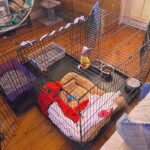Who wants their pup to be unclean and messy, especially if they live indoors? A clean dog is usually the epitome of a healthy dog, but consistent hygiene requires practice! If “practice” begins when your dog is a puppy, keeping your dog clean throughout its life should be simple.
What Is the Importance of Hygiene for My Pet?

Dogs maintain their own hygiene in the outdoors without human interference, but this level of cleanliness is rarely acceptable for human interaction. Because humans and dogs have different notions about what constitutes “dirty,” the regimen we impose on our pets may be incompatible with their nature. Dogs do not wash their teeth or take baths on their own, thus they must be introduced to the hygienic requirements of domestic living with humans as puppies.
How to Handle Diapered Puppies and Older Dogs?

A puppy diaper may provide additional comfort and safety if your pet scoots around. The dog diapers serve to keep dirt and germs from entering the urethra and triggering a urinary tract infection. However, if you do not change your diaper regularly, you increase your risk of developing a urinary tract infection because bacteria from faeces or urine can travel back up the urethra.
When we use dog diapers, we take away their natural ability to groom or clean this area, so it is your responsibility as an owner to brush the coat regularly, give your dog breaks from diapers, check for rashes, and make sure your pet is completely clean and dry before applying a new diaper.
Some dogs, like human babies and the elderly, will require diapers throughout their lives. There are numerous reasons why a dog may need to wear one, as well as various varieties of canine diapers. Although diapers can be beneficial for some dogs, you should carefully use them under the guidance of a veterinary doctor.
How Do I Get My Dog to Enjoy Being Brushed?

Brushing puppies frequently respond favourably to gradual introduction. First, get your dog used to being touched. Hold your dog while softly but firmly running your hands down his back in gradual strokes that are more relaxing than brisk ones. Massage his tummy, legs, and feet.
Then massage his neck and ears. While massaging your dog, speak calmly to him. Repeat 5-minute sessions throughout the day. Try using a soft bristle brush and offering treats or food rewards as a diversion and for positive conditioning when your pup readily allows you to handle him.
If your dog fights, fidgets, or cries, stop immediately but do not release him. Hold him and speak to him till he calms down. When he calms down, give him praise or a treat and resume brushing.
How Do I Get My Dog to Take a Bath?
Bathing should be a pleasurable experience. Puppies prefer being licked by their moms as infants, so learn from mommy dogs. First, ensure that the water has been warmed to body warmth (similar to the mother’s saliva). Mama dog does not splash her pup, and we should not either.
Pour water over the pup gently, beginning with the body and working your way down to the feet. Wash the pup’s face with a wet cloth to avoid getting water in his eyes. To prevent your eyes from getting irritated, use an approved ophthalmic lubricant. Using firm, slow strokes, gently bathe the coat with a medically approved puppy shampoo. Rinse the puppy thoroughly with warm water.
How Do I Get My Dog to Tolerate Having His Teeth Brushed?
Although chewing dry food helps dogs remove plaque from their teeth, it is just not enough to prevent periodontal disease in the long run. Human intervention is essential to postpone health consequences caused by poor dental health (e.g., heart disease, renal failure). Brushing teeth, like most elements of canine hygiene such as using worm treatment , does not come naturally to puppies.
The first step is to accustom the puppy to having his mouth handled. Begin by softly touching your pup’s muzzle several times per day, then raise his lips and rub his gums with your fingertips. Then, using gauze or a damp face towel, run your finger down the surface of his gums. Finally, introduce a toothbrush and toothpaste once he is quietly allowing you to touch his gums and teeth. Use a soft-bristled toothbrush and dog-safe enzymatic toothpaste. Because puppies do not swish or spit, toothpaste that is swallowed must be safe.
How Do I Train My Dog to Get Used to Clipping/Grooming?
Whether you groom your dog yourself or hire a professional, the process can be frightening for puppies. Electric clippers can be frightening in terms of sight, sound, smell, and sensation. When the pup is comfortable with the sight and sound of the clippers, switch them off before touching his coat. Allow them to feel the weight of the clippers as you slide them softly along the fur’s growth pattern. Finally, switch on the clippers and trim some hair. Keep your first grooming sessions brief.



